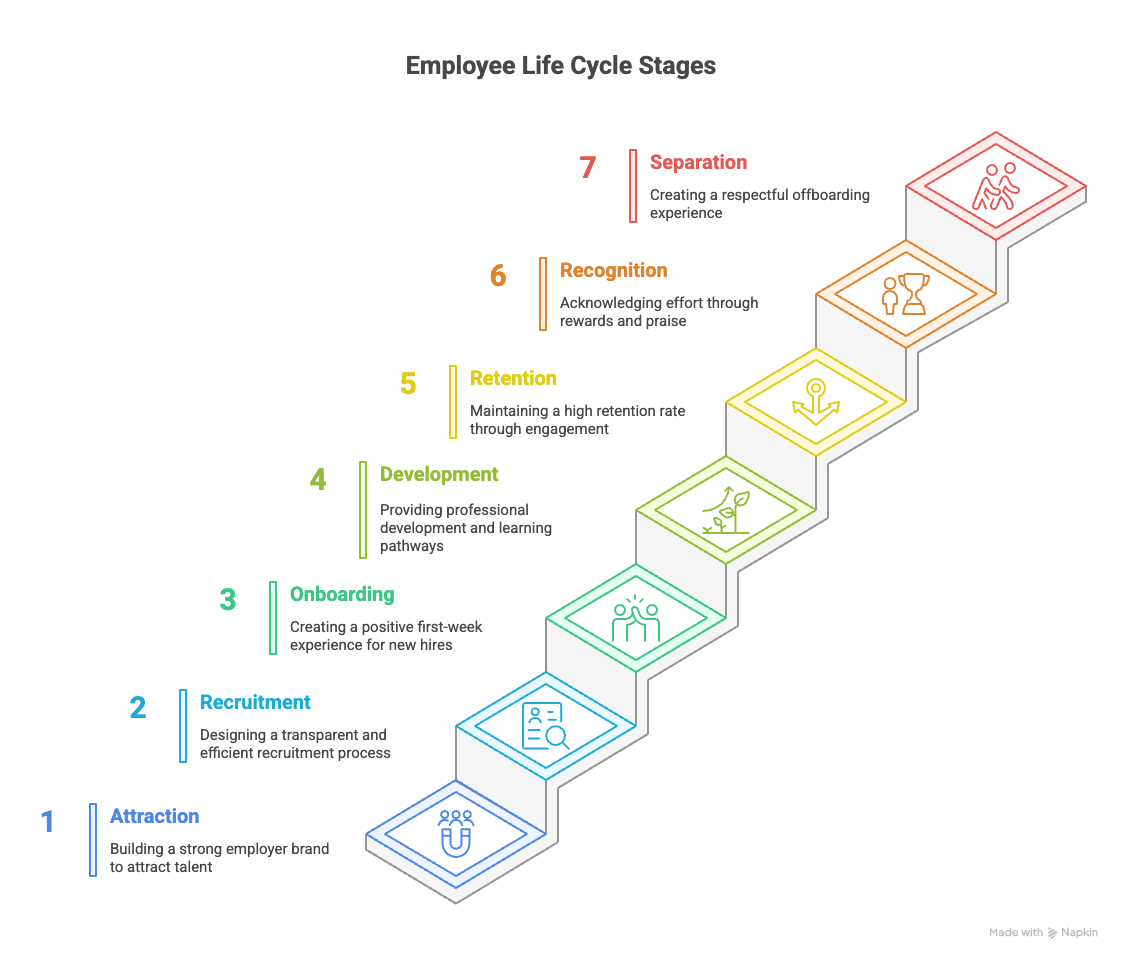Understanding and optimising each stage of the employee life cycle helps organisations improve the recruitment process, attract and retain top talent and build a strong workplace culture of growth and professional development. As leading outsourcing HR experts, we’ll break down the seven key stages of the employee lifecycle and provide practical tips for HR professionals to enhance their employee lifecycle.
Ready to improve your employee retention rate? Get in touch with our team of experts for a free audit today.
What Is the Employee Life Cycle?
Definition and Why It Matters
The employee life cycle (ELC) is a structured HR framework that tracks every stage of the employee journey. This model is essential for organisations to understand strategic workforce planning and employee engagement, and development. These are typically strong indicators of employee retention rates and indicate to organisations if there are any issues with the current company culture or employee development plans. It also provides a consistent HR process and improves performance strategies.
The Employee Life Cycle Diagram
When structuring an employee life cycle, following the phases of the employee life cycle model can help HR professionals identify where there may be inconsistencies or gaps in the employee journey. It also helps improve current workplace policies and procedures. We recommend using this when planning strategic business growth sessions or recruitment processes.

The Seven Stages of the Employee Life Cycle
Stage 1 – Attraction
The employee life cycle starts well before a contract is signed. During the attraction phase, potential employees form their first impressions of your brand.
Key elements include:
- A strong employer brand that reflects your values and culture
- Targeted social media messaging and careers pages that resonate with your ideal candidates
- Clarity on your mission and workplace environment
A compelling attraction strategy draws in candidates who align with your company culture and long-term goals. This is important as it helps improve retention rates and attract top talent.

Stage 2 – Recruitment
Once a candidate has expressed interest, the recruitment process begins. This stage is your opportunity to assess fit and showcase your company as a desirable place to work.
Best practices include:
- A transparent hiring process that clearly outlines expectations
- Well-structured interviews that evaluate both technical skills and cultural alignment
- Prompt, clear communication to reduce delays and keep top candidates engaged
A streamlined recruitment strategy reflects positively on your brand and can significantly reduce offer rejection rates.

Stage 3 – Onboarding
Onboarding sets the tone for an employee’s entire journey. It is an organisation’s responsibility to have a structured onboarding process that sets the employee up for success. A thoughtful, well-structured onboarding process increases engagement and speeds up time-to-productivity.
Key goals include:
- Helping employees feel welcomed, prepared, and supported
- Clearly communicating role expectations and company values
- Offering early feedback and connection points with their team
Onboarding is also a critical moment to reinforce compliance, safety, and performance expectations.

Stage 4 – Employee Development
Employees want career growth, and this stage is where you deliver on that expectation. Development isn’t just about training; it’s about ongoing support, feedback, and future-focused opportunities.
Consider offering:
- Learning pathways and access to continuous education
- Mentorship and coaching programs
- Career progression frameworks tied to performance
Employees who feel supported in their growth are more likely to stay, contribute, and advocate for your business.

Stage 5 – Retention
Retention is about keeping your high performers engaged, motivated, and loyal. It’s not just about salary, it’s about how people feel at work. It also communicates to potential candidates that your organisation is a place where employees feel valued and cared for.
Strategies to improve retention include:
- Regular check-ins and open lines of communication
- A focus on employee wellbeing and flexibility
- Identifying and resolving early signs of disengagement or burnout
Monitoring turnover data and exit interviews helps identify which departments or roles need additional attention.
Stage 6 – Recognition
Recognition helps employees feel valued for their contributions. This stage influences morale, motivation, and long-term engagement.
Recognition can include:
- Formal reward programs for achievements or milestones
- Informal praise in meetings, messages, or team channels
- Opportunities for internal progression or leadership development
When employees feel seen and appreciated, they’re more likely to go above and beyond for your organisation.

Stage 7 – Separation
There comes a time when every employee leaves a role. Whether it’s retirement, resignation, or restructuring, the separation process should be handled with professionalism and respect.
Best practices include:
- Exit interviews to gain insights into why employees are leaving
- Smooth offboarding processes, including knowledge transfer and final documentation
- Using feedback to refine earlier stages of the employee life cycle
A positive separation experience can result in lasting goodwill and even future rehires or referrals.

Why the Employee Life Cycle Framework Is Valuable
A Holistic View of HR
Without a clear understanding of the employee life cycle, organisations will have a hard time pinpointing where issues arose, blind spots and how they can improve their company culture and employee engagement. That is where the employee life cycle model has clear value, as it provides a structured approach to workforce management.
Improving Employee Experience
At the base of it, the employee life cycle is there to improve employee experience. It helps communicate to HR where they need support and how they can help employees to feel seen, supported and aligned with the company mission throughout the stages of their employment.

Best Practices to Improve Every Stage
Embed Company Culture Across the Life Cycle
Your values should be clear from the first interaction through to the exit interview.
Here are some ways we suggest to reinforce culture:
- Attraction messaging that reflects your brand
- Onboarding processes that communicate values in action
- Development initiatives that support both technical and cultural growth
Consistency in how culture is lived builds trust and loyalty. This also establishes strong employer branding and can attract top talent as potential workforces learn about your company culture.
Gather Feedback Regularly
Taking regular feedback from employees throughout their employment is an opportunity to learn and improve. Using tools such as anonymous employee surveys, one-on-one check-ins and exit interviews at termination are a great way to refine the employee experience.
Partner with HR Experts
For expert advice on how to develop and improve your employee lifecycle, consider partnering with strategic workforce planning consultants such as E.L Blue as we can provide strategic insight and up-to-date legal advice.
At E.L Blue, we help businesses:
- Design and implement customised HR frameworks
- Improve workforce planning and performance management
- Navigate compliance through expert workplace relations support
Whether you’re scaling your business, managing a hybrid team, or refining your culture, a trusted HR partner ensures every stage of the employee journey is aligned and effective.
Ready to Strengthen Your Employee Experience?
Optimising the employee life cycle isn’t just good HR, it’s good business. By refining each stage, you create a workplace that attracts top talent, supports employee growth, and drives long-term success.
Need help managing your employee journey from attraction to exit?

